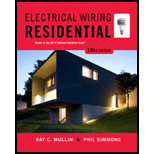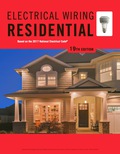
Electrical Wiring Residential
18th Edition
ISBN: 9781285170954
Author: Ray C. Mullin, Phil Simmons
Publisher: Cengage Learning
expand_more
expand_more
format_list_bulleted
Concept explainers
Question
Chapter 25.3, Problem 13R
To determine
Name the size of a wire that is used for installing signal systems in a residence.
Expert Solution & Answer
Want to see the full answer?
Check out a sample textbook solution
Students have asked these similar questions
a 1. What is the transpose system. What is the advantage of it.
2. What is the intersheath grading. What is the advantage of it.
3. What is the difference between redial and ring distribution system.
Please show all the steps!
Please show all the steps!
Chapter 25 Solutions
Electrical Wiring Residential
Ch. 25.1 - How many television outlets are installed in this...Ch. 25.1 - Which type of television cable is commonly used...Ch. 25.1 - What determines the design of the faceplates used?...Ch. 25.1 - Prob. 4RCh. 25.1 - From a cost standpoint, which system is more...Ch. 25.1 - Prob. 6RCh. 25.1 - Prob. 7RCh. 25.1 - Prob. 8RCh. 25.1 - Which article of the Code references the...Ch. 25.1 - It is generally understood that grounding and...
Ch. 25.1 - Prob. 11RCh. 25.1 - Prob. 12RCh. 25.1 - Which section of the Code prohibits supporting...Ch. 25.1 - When hooking up one CATV cable and another cable...Ch. 25.1 - Prob. 15RCh. 25.1 - Prob. 16RCh. 25.2 - How many locations are provided for telephones in...Ch. 25.2 - At what height are the telephone outlets in this...Ch. 25.2 - Sketch the symbol for a telephone outlet.Ch. 25.2 - Is the telephone system regulated by the NEC?...Ch. 25.2 - a. Who is to furnish the outlet boxes required at...Ch. 25.2 - Who is to furnish the telephones? _____Ch. 25.2 - Who does the actual installation of the telephone...Ch. 25.2 - How are the telephone cables concealed in this...Ch. 25.2 - Prob. 9RCh. 25.2 - What are the colors contained in a four-conductor...Ch. 25.2 - Itemize the code rule for the installation of...Ch. 25.2 - If finger contact were made between the red...Ch. 25.2 - What section of the Code prohibits supporting...Ch. 25.2 - The term cross-talk is used to define the hearing...Ch. 25.2 - Which section of the Code prohibits telephone...Ch. 25.3 - Prob. 1RCh. 25.3 - What style of chime is used in this residence?...Ch. 25.3 - a. How many solenoids are contained in a 2-tone...Ch. 25.3 - Explain briefly how two notes are sounded by...Ch. 25.3 - a. Sketch the symbol for a push button....Ch. 25.3 - Prob. 6RCh. 25.3 - What is the maximum volt-ampere rating of...Ch. 25.3 - What two types of chime transformers for Class 2...Ch. 25.3 - Is the extension chime connected with the front...Ch. 25.3 - a. What change in equipment may be necessary when...Ch. 25.3 - What type of insulation is usually found on...Ch. 25.3 - Prob. 13RCh. 25.3 - a. How many wires are run between the front hall...Ch. 25.3 - Why is it recommended that the low-voltage...Ch. 25.3 - a. Is it permissible to install low-voltage Class...Ch. 25.3 - a. Where is the transformer in the residence...Ch. 25.3 - a. How many feet of 2-conductor bell wire cable...Ch. 25.3 - Prob. 19RCh. 25.3 - Prob. 20RCh. 25.3 - What section of the Code prohibits supporting fire...Ch. 25.3 - Prob. 22RCh. 25.3 - What does the term Wi-Fi stand for? _____Ch. 25.3 - A Wi-Fi system is (required) (optional). (Circle...
Knowledge Booster
Learn more about
Need a deep-dive on the concept behind this application? Look no further. Learn more about this topic, electrical-engineering and related others by exploring similar questions and additional content below.Similar questions
- 10-3) similar to Lathi & Ding, Prob. P.6.3-7 The Fourier transform P(f) of a the basic pulse p(t) used in a certain binary communication is shown in the figure below: P(f) 1 0.5 0 f₁ = 0.8 √₂ = 1.2 f, MHz (a) From the shape of P(f), explain at what pulse rate this pulse would satisfy Nyquist's first criterion. (b) Assuming that the pulse is a raised-cosine pulse, find its rolloff factor. (c) Find p(t) and verify that this pulse satisfies Nyquist's first criterion in the time domain. (d) Show how rapidly the pulse decays as a function of t, (i.e., what power of t does the envelope obey for large time values).arrow_forwardDon't use ai to answer I will report you answerarrow_forwardDon't use ai to answer I will report you answerarrow_forward
- Don't use ai to answer I will report you answerarrow_forwardChoose the correct answer for from the following sentences: 1. The purpose of the microprocessor is to control b. memory c. processing d. tasks a. switches 2. Which of the following instructions represents base-plus-index addressing mode? a. MOV AL,[BX] b. MOV AL,[SI] c. MOV AL,BX d. MOV AL,[BX+SI] 3. The BIU pre-fetches the instruction from memory and store them in b. memory c. stack d. queue a. register 4. Which function is used to control the PWM (Pulse Width Modulation) on the Arduino output pin? a. digitalRead() b. analogRead() c. digitalWrite() 5. Which port in the PIC16F877A has an 8 external interrupt inputs? a. Port-A b. Port-C c. Port-B d. analogWrite() d. Port-D d. 4KByte 6. How much Flash EEPROM memory program found in the PIC16F877A microcontroller? a. 32KByte b. 16KByte c. 8KBytearrow_forwardSolve and select the correct answer: 2. For a random variable X with pdf: p(x) value of x is = 119 10 for -5≤x≤5. The mean (a) -75 (b) 10 (c) 0 (d) 75 3. Is the matrix A = = [1] orthogonal? Find the rank of A? 0 (a) YES, -1 (b) NO, 2 (c) YES, 2 (d) NO, -1 4. L{et sin(3t)u(t)) = (a) s-3 (s-2)²+9 2 (b) (5-3)² (c) (s-3)²+4 S-2 3 (s-2)²+9 (d) (5-2)²+9 = 5. Given that x is a constant. Choose all the correct solutions for [∞ (AB)] = (a) (AB)T (b) x ATBT (c) α BTAT (d) x (AB)Tarrow_forward
- DO NOT WANT AI WILL REJECTarrow_forward3. Roughly sketch the root locus for the following locations of open-loop poles and zeros. You just need to show the shape of the root locus; you do not calculate the asymptote, break-in, and break-away points. ☑ (a) (b) ☑ Φ ① $3 (c)arrow_forwardDO NOT WANT AI WILL REJECTarrow_forward
arrow_back_ios
SEE MORE QUESTIONS
arrow_forward_ios
Recommended textbooks for you
 EBK ELECTRICAL WIRING RESIDENTIALElectrical EngineeringISBN:9781337516549Author:SimmonsPublisher:CENGAGE LEARNING - CONSIGNMENT
EBK ELECTRICAL WIRING RESIDENTIALElectrical EngineeringISBN:9781337516549Author:SimmonsPublisher:CENGAGE LEARNING - CONSIGNMENT

EBK ELECTRICAL WIRING RESIDENTIAL
Electrical Engineering
ISBN:9781337516549
Author:Simmons
Publisher:CENGAGE LEARNING - CONSIGNMENT